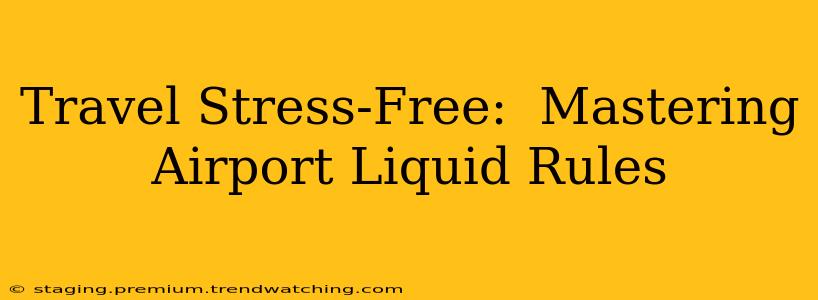Air travel can be stressful, but navigating airport security doesn't have to be one of those stressors. Understanding and adhering to the Transportation Security Administration (TSA) liquid rules is key to a smooth and efficient journey. This comprehensive guide will equip you with the knowledge to breeze through security checkpoints, leaving the liquid-related anxieties behind.
What are the TSA liquid rules?
The TSA's 3-1-1 rule is the cornerstone of their liquid regulations. It dictates that passengers can bring travel-sized liquids, aerosols, gels, creams, and pastes in their carry-on baggage, but these items must adhere to specific size and packing requirements. These items must be in containers of 3.4 ounces (100 milliliters) or less per item. All of these containers must then be placed in one, quart-sized, clear, resealable plastic bag. Each passenger is limited to one such bag. This simple rule, when followed correctly, significantly speeds up the screening process.
What counts as a liquid?
Many travelers are unsure what exactly constitutes a "liquid" under TSA regulations. The list is broader than you might think. Beyond the obvious like water bottles and lotions, it includes:
- Shampoo and conditioner: Even those small travel sizes must adhere to the 3-1-1 rule.
- Toothpaste: Both tubes and travel-sized containers are subject to the regulations.
- Mouthwash: Any liquid mouthwash falls under the 3-1-1 rules.
- Creams and lotions: Sunscreen, hand cream, face moisturizer – all need to be in containers of 3.4 ounces or less.
- Gels: Hair gel, shaving gel, and similar products must be in the approved containers.
- Aerosols: Hairspray, deodorant, and other spray cans are included.
- Food items: Jams, jellies, sauces, and other similar food items that are liquid or semi-liquid must follow the rules.
Remember, even if a product is labeled "travel size," ensure it meets the 3.4-ounce (100ml) requirement.
What if I have medication or baby food?
H2: Can I bring medication in my carry-on?
Yes, you can bring necessary liquid medications in your carry-on baggage. However, you may need to declare them separately to TSA officers. It's recommended to have your prescription readily available for inspection. Larger quantities of medication may require special documentation from your physician. For baby food and formula, TSA allows larger quantities as needed; however, these will need to be screened separately.
What if I forget the 3-1-1 rule?
H2: What happens if I don't follow the 3-1-1 rule?
If you don't comply with the 3-1-1 rule, the TSA will likely confiscate your non-compliant liquids. This can be inconvenient and frustrating, leading to delays and potentially causing you to miss your flight. To avoid this, thoroughly check your carry-on bag before heading to the airport.
Can I bring liquids in my checked baggage?
H2: Can I put liquids in my checked baggage?
Yes, liquids are generally permitted in checked baggage, but there are some restrictions. You should still check the TSA website for any updates and specific prohibited items. However, packing liquids in your checked bag eliminates the need to worry about the 3-1-1 rule. This is a great strategy for bulkier, larger containers of lotions, shampoos, and other toiletries.
What are some tips for packing liquids for air travel?
H3: How can I best pack my liquids to avoid TSA issues?
- Plan Ahead: Prepare your quart-sized bag and sort your toiletries well in advance of your trip.
- Use Travel-Sized Containers: This is the easiest way to meet the 3.4-ounce requirement.
- Label Everything: Clear labeling helps TSA agents quickly identify your items.
- Double Bag It: Consider using a second bag or container around your liquids for added protection against leaks.
- Check the TSA Website: Regularly check the TSA website for updates to the rules and any new regulations.
By following these tips and understanding the TSA liquid rules, you can significantly reduce your stress level and enjoy a more relaxed travel experience. Remember, preparation is key to a smooth journey!

